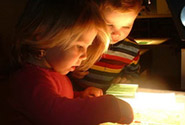The Intriguing World of Sticky

A young child is intrigued when an object sticks to her fingers. The object looks normal. It should fall from her fingers when released. Sticky objects present surprises, like two magnets that repel, large empty detergent jugs that are not heavy, a long block with a hidden weight at the end so that it does not balance in the middle. These surprises cause children to rethink their assumptions about how the physical world works. We can use the surprise nature of sticky surfaces as the reason to include them in the preschool. Sticky surfaces also present children with non-trivial problems to solve. In this set of video clips we see:
- How do I get a sticky object off my fingers? I can shake my fingers. But if that does not work, I can pull the object off with my other hand?
- But what do I do when the object I want to get rid of sticks to the hand I used to remove it? I can wipe in on the chair or bite into it. Click here to watch.
- How can I walk on a sticky surface without falling over? I can be sure I am balanced before taking a step. I can lift my feet in a more vertical way instead of swinging my feet forward as I do on non-sticky surfaces.
- How do I get a sticky object to stick to another surface? Children might use this sequence: 1. Find the sticky side. 2. Place sticky side of tape on wall. 3. Press firmly.
- Does the child simply remember to press firmly or does the child understand that pressing the tape causes the sticky stuff to grip the surface better? What does a child think is happening when she presses firmly?
- What might a young child do when he presses tape to a moist surface and the tape does not stick? Does he simply press more firmly? Is he aware that water adds a thin film that prevents a good bond between the sticky surface and the supporting surface? Wouldn't it be interesting to ask children to draw what they think is happening between the surfaces that cause the object not to fall or how the moisture prevents the tape from staying put? You might try this with five year olds with some success.
- How do I get sticky tape to join the sides of folded paper? Watch how Chaislyn folds the paper and then presses the tape to the folded paper, but does not quite understand the way to align the adjacent sides so that the tape will span both sides. Click here. Does she think that the tape just needs to be placed anywhere on the folded paper? Perhaps, but with the teacher's help she has some success.
- Do children understand which surface is sticky if they press a non-sticky object to a stationary sticky surface?
- They may expect the object will not fall, but do they think that the object pressed is sticky rather than the stationary surface? There is a difference between being sticky and being stuck. A non-sticky object can be stuck to a sticky surface. As you no doubt are beginning to see, the world of sticky surfaces contains some non-trivial problems to solve and some interesting relations to ponder.Length of videative: 2 text pages, 8 video subclips Keywords: Mixed Ages, Child-Object, Environment, Problem-Solving, Adhesiveness, Cause-Effect, Videative
